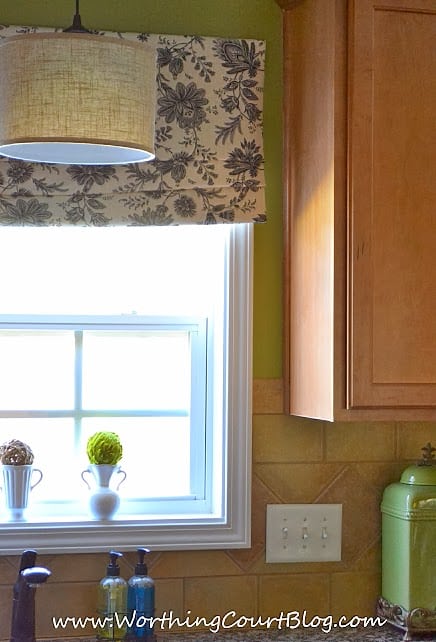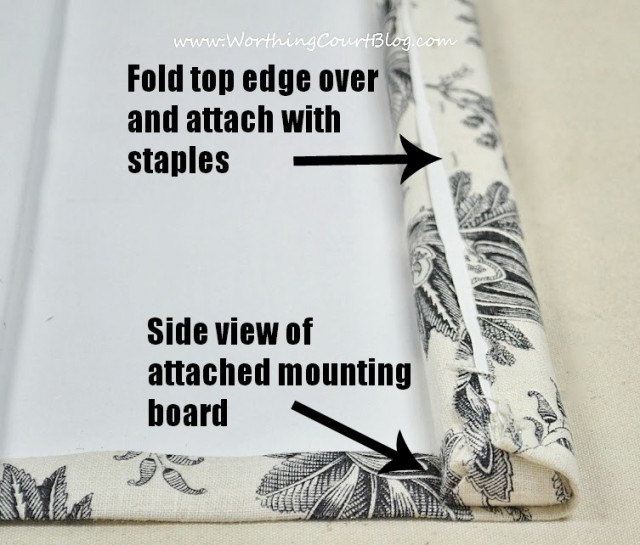This faux roman shade was made for the kitchen of my previous home. We’ve moved and are giving our new-to-us home a total remodel. Click HERE to take a look!
I love the roman shade that I made for my kitchen and I’m excited to share the how-to with you today.
My shade is actually a faux roman, plus it’s no sew. That’s the best of both worlds if you don’t know how (or want) to sew and don’t want to spend a lot of money on fabric!

Just a little bit of fabric at a window makes such a huge difference in a room. Plus the folds of the fabric add some of that all important texture.

Before we get started, there are a couple of things to tell you:
*The finished dimensions of my shade are 41″ wide x 16″ high. If your shade will be a different size, the steps are the same, but you will need more or less fabric than I used and all dimensions that I give you in the directions should be adjusted accordingly.
*If you’re using a patterned fabric, decide where you want the pattern to fall at the top, bottom and middle of the shade before cutting.
*This one is important! Stop several times throughout the process to check the shade for squareness. Do this by measuring each side of the shade after a step is completed. Make adjustments as you go – don’t wait until the end.
*My shade is only perfectly straight across the very bottom. I wanted it to have a slightly relaxed look, so you may notice that the folds are not perfectly straight. If you want all of your folds to be straight across the bottom, you will need to use hot glue to create a pocket for a wooden dowel where each fold is located.
*All of my photos were taken on the well “loved” table in my drapery workroom. That explains why you’ll see some lines and smudges on the fabric covering the table.
SUPPLIES
*1 yard of 54″ wide, decorator fabric
*1 yard of drapery lining, I used blackout lining on mine, but regular white lining is fine
*fusible bonding tape, such as Stitch Witchery
*hot glue gun and glue sticks
*needle and thread that matches the fabric
*staple gun and staples
*one 1/2″ diameter wooden dowel rod, cut to the finished width of the shade
* one 1″ x 2″ board, cut to the finished width of the shade
*straight pins
*scissors
*measuring tape
*iron

Directions
Step one – remove the selvage and cut the fabrics
Cut the selvage away from each side of the fabric. You want to do this first, because the selvage is often woven more tightly than the body of the fabric and will throw off your measurements on the sides.

Cut the width of the main fabric to equal the width of the finished shade, plus 8″. {The finished width of my shade was 41″, so I cut my fabric to be 49″ wide.}
Cut one yard of lining to equal the finished width of the shade. No extra width is needed.
Hem the sides
Lay the main fabric right side down and lay the lining fabric on top of it, right side up. Center the lining fabric so that there is an equal amount of the main fabric showing on each side.

On one side, fold the excess main fabric over to meet the edge of the lining. Press in place.

Fold again over the lining and press in place.

Lay the fusible web tape under the edge of the folded down fabric. Follow the manufacturers directions to adhere the fabrics together.

You should wind up with a hem that is 2″ wide.
Repeat on the opposite side.

Hem the bottom and create a pocket for the dowel
The wooden dowel will be inserted through a pocket formed at the bottom of the shade. It will act a stabilizer for the shade and will keep the bottom of the shade straight.
Fold the bottom edge of the shade up 1/2″ and press into place.

Fold up another 1 1/2″ and press into place.
Run a bead of hot glue along the folded edge of the fabric to secure.
You’ve now created a pocket to hold the dowel.
Hand stitch the pocket opening closed on each side of the shade to keep the dowel from falling out.

Create the folds of the shade
Holding both layers of the fabric securely, turn the shade over so that the main fabric is right-side-up. Smooth the layers of fabric out, making sure there are no wrinkles anywhere.
Place a pin on each side of the shade to mark where the folds will be created.
I knew that I wanted a 3″ reveal at the bottom of my shade (before the first fold) and another 3″ reveal between the first and second folds. I also knew that I wanted each of my folds to be 7″ deep.
My pins are placed like so:
#1 pin is 3″ from the bottom
#2 pin is 7″ from the #1 pin
#3 pin is 3″ from the #2 pin
#4 pin is 7″ from the #3 pin

Grab hold of each side of the shade at pin #2 and bring in down to meet pin #1.
Bring pin #4 down to meet pin #3.
In the photo below, you can see the fabric is folded and the pins are “stacked” one on top of the other.

Run a bead of hot glue up under all of the folds – both on the sides and all the way across the front, under the bottom edge of the folds.

Allow the glue to cool and flip the entire shade over. Repeat the same gluing process on the back of the shade.

Attach the shade to the mounting board
At this point, your shade is finished! Now you just need to attach is to the 1″ x 2″ board so that it can be mounted to the wall.
Cover the 1″ x 2″ board with fabric by wrapping it around the board and stapling it in place. Make sure you finish the ends off nicely for a professional look.
{I used excess fabric that was left over from cutting the main fabric down to the proper width.}
Lay the board at the top edge of the shade, on the lining side. Lay it far enough down from the top so that there is just enough fabric to wrap it around the board and staple it into place. Make sure the board is perfectly straight before stapling.


Mount the shade
Pre-drill holes through the board in preparation for attaching it to the wall. Reach up under the shade to drill the holes – make sure you do not drill through the face of the fabric.
To mount the shade to the wall, turn it so that the face of main fabric is facing toward you.
Place the board at the location the top of the shade is to be located.
Flip the fabric up, and drill straight through your pre-drilled holes, into the wall. You may need to use wall anchors if there is no stud to drill into.

And that is it – you are done!

Original article and pictures take www.worthingcourtblog.com site
Комментариев нет:
Отправить комментарий